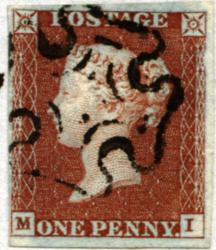Postal History of Gatehouse of Fleet
The Gatehouse MX
By 1840 the British postal service had benefitted from the following measures, largely brought about by Sir Rowland Hill :
(a) a uniform postal rate throughout the UK, instead of the cost being distance related,
(b) reduced cost of sending a letter from 4d to 1d,
(c) introduction in 1840, of the world's first adhesive postage stamps, the penny black and the twopenny blue, followed a year later by the penny red.
(d) changing the responsibility for payment for letter carriage from being made by the receiver to being prepaid by the sender.
Each postmaster was required to arrange for a special rubber ‘stamp’ to be made which would then be pressed into a ink-impregnated pad before being applied to the adhesive stamp on a letter so as to “obliterate” the stamp to prevent it from being re-used. The postmaster was also responsible for mixing the ink from a recipe of components.
Initially the ‘obliterating stamps’ were used with black ink, but cleaning and re-using penny blacks became commonplace. Hence, firstly the ink was changed from black to red, but the more permanent solution was to change the adhesive from black to red and revert to using black as the obliterating ink.
The “cancellation” left behind when the rubber stamp had been applied became known as a “Maltese Cross”, although some would argue that this is not an appropriate description of the shape. This method of “cancelling” stamps with a maltese cross was used from 1840 until it was replaced by a numeral cancel, which was location dependant, in 1844.
Because the maltese cross (MX) obliterating stamps were commissioned independently it is not surprising that some became more instantly recognisable than others. The Gatehouse maltese cross would originally have looked similar to this picture :

After about 2 years of use the central diamond had disappeared, as had much of the inner cross. This deterioration helps to identify stamps which have been cancelled by a Gatehouse MX, even if the stamp has been removed from its cover.
This stamp was cancelled in Gatehouse on 8th April 1841 and the full MX is still there :

The following stamps were cancelled in Gatehouse during 1843, by which time it is clear that the central diamond and parts of the inner cross have disappeared.



10th Jan 1843 7th Aug 1843 25th Sep 1843
The Gatehouse “1844” cancel.
In 1844 the Maltese Cross cancel was replaced by an obliterator that identified the nearest post office to the place where the letter was posted. The new cancel consisted of a series of horizontal lines with a space in the middle which held a 1, 2 or 3-digit number.. In England & Wales the overall shape of the cancel was oval. In Ireland it was diamond-shaped, whilst in Scotland it was rectangular. In all cases the number of horizontal lines can vary. The number in the middle was specific to each post office. In Scotland, Aberdeen was number 1. Edinburgh was 131, Glasgow was 159, and Gatehouse was 157.
.jpg)
.jpg)
.jpg)

